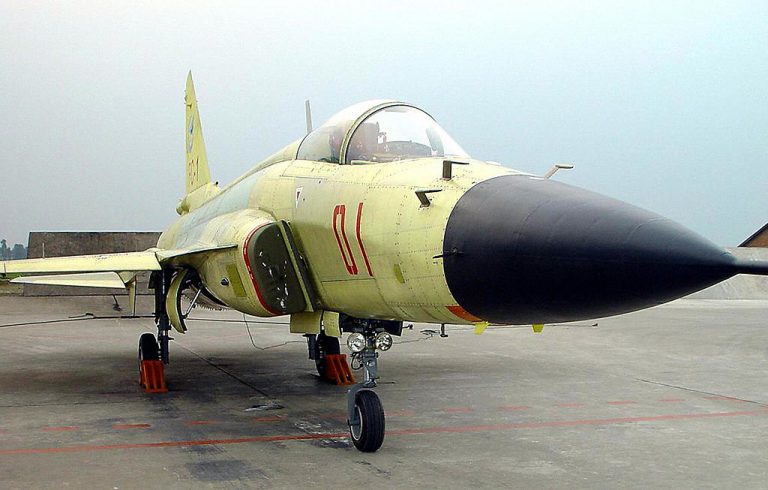A Chinese air force fighter jet crashed during a training session in China’s central province of Hubei. The accident, which took place in Laohekou, Xianyang on the morning of June 9, killed one person on the ground and injured two others, according to state media reports.
State broadcaster CCTV’s military channel reported that the J-7 fighter jet went down near the airport in Xianyang and that the pilot had managed to eject himself from the plane and parachute to safety. The pilot was then taken to a local hospital for examination along with the two injured members from the public.
CCTV added that the cause of the crash is currently being investigated and that the accident destroyed several houses. Videos posted by state news agency Xinhua, and widely circulated on Chinese social media, showed several houses on fire at the scene of the crash.
The reports were unusual because China generally keeps military accidents under wraps or emphasizes the heroic role of the pilot in avoiding casualties on the ground, the Washington Post reported.
RELATED:
- China Eastern Plane Crash That Killed All 132 Onboard in March Was Likely Intentional: Reports
- Beijing Censors Reports on China Eastern Crash That Claimed 132 Lives
- Taiwan Air Force Jet Makes ‘Hard Landing’ in Hawaii After Aircraft Malfunction
The J-7 crash comes days after a pair of crashes involving the Taiwanese air force, including that of a F-16 flighter where the landing gear failed to deploy, and a fatal incident that killed the pilot of an AT-3 trainer aircraft.
Success
You are now signed up for our newsletter
Success
Check your email to complete sign up
Developed in the 1960s, the J-7 fighter jet was developed as a Chinese copy of the Soviet MiG-21 fighter, the most widely-produced supersonic military aircraft in history. Its production was suspended in 2013 and a derivative aircraft is now mainly used for pilot training, the South China Morning Post (SCMP) reported.
The crash also follows the recent China Eastern Airlines tragedy, in which a Beoing airliner took a nosedive into a mountainous area of the southern Guangxi Zhuang region in March, killing all 132 passengers and crew on board and becoming the country’s deadliest air disaster in over a decade.
The Boeing 737-800 aircraft was en route from Kunming to Guangzhou when it lost all communication with air traffic control and plummeted from a cruising altitude of about 30,000 feet, according to China’s civil aviation authority (CAAC).
‘Reckless flying’
There have been several other cases of fighter jets crashing during training flights in China. In 2015, a Chinese air force pilot parachuted to safety moments before his aircraft crashed into a hillside. Two years before that, a military pilot died when his fighter jet went down during a night training session in the eastern province of Zhejiang.
The 2016 crash of a J-10 fighter, which was designed in China, killed Yu Xu, the country’s first female military pilot. There have been several other crashes involving the J-10, which incorporated both Israeli and existing Chinese technology in its development.
A few countries have recently also complained of “reckless flying” by Chinese fighter jets, claiming these incidents have endangered the lives of their crews during military surveillance operations.
READ MORE:
- Black Boxes Recovered From Ill-fated China Eastern Flight, Begin Analysis
- Australia Accuses Chinese Jet of Intercepting Its Surveillance Plane and Endangering Crew
- Canada Slams China for ‘Harassing’ Its Patrol Aircraft
“In these interactions, the People’s Liberation Army Force (PLA) aircraft did not adhere to international air safety norms,” the Canadian Armed Forces (CAF) said in a June 1 statement following several incidents where Chinese aircraft approached Canadian reconnaissance planes as they monitored North Korea for possible violations of U.N. sanctions.
“These interactions are unprofessional and/or put the safety of our Royal Canadian Air Force personnel at risk,” the statement said, adding that in certain instances, the Canadian aircrew felt so at risk that they had to quickly change their flight path in order to avoid a potential collision with the intercepting Chinese aircraft.
In a televised interview that came after the Canadian reports, Australian Defense Minister Richard Marles said on June 7 that a Chinese J-16 fighter jet was on patrol alongside the Australian P-8 when it suddenly released flares and cut in front of the reconnaissance plane.
Marles added that during the incident, the Chinese jet “released chaff” that entered into one of the Australian aircraft’s engines — posing a severe safety risk.
Military planes usually release chaff — which are typically tiny strips of aluminum or zinc — as a deliberate countermeasure to confuse radar-guided missiles, but they can also be used to sabotage pursuing aircraft.














